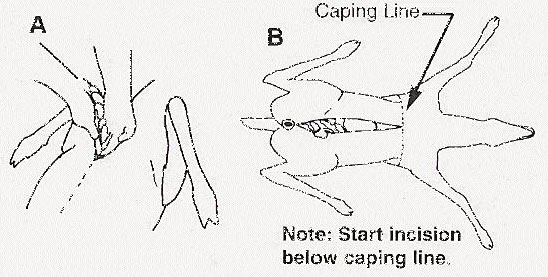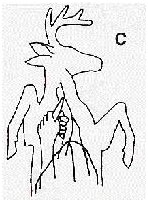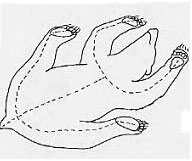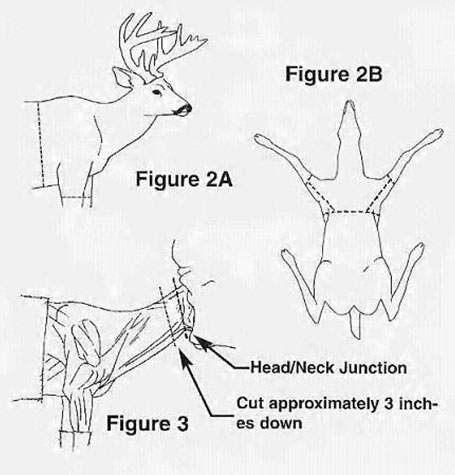Field Care / Transportation
|
Over the years, we have done hundreds of game animals and feel that we can accommodate our clients in just about whatever they are looking for. All incoming work must be documented with proper identification, licenses and tags. As hunters, we all spend so much time and money achieving that trophy of a lifetime. When planning your hunt, plan for trophy care as well. Too many times we see ruined trophies because of improper field care.
In the case of large animals such as elk or bear, get them skinned out immediately after harvesting, the body heat of a thick animal can spoil the skin as well as the meat. This can happen even in sub-zero temperatures.. If you have any questions, before, during or after your hunt, please give us a call. Shop: 408.354.4216 or Cell: 408.656.5705. Good Hunting! |
Field Care Instructions
Field Dress:
1. With deer on its back make a shallow cut through the skin just below the breastbone. Make sure that you start your cut well away from the brisket allowing plenty of uncut skin for your shoulder mount. Insert two fingers of the free hand, cradling the blade, to hold the skin up and away from the entrails (figure A).
2. Cut straight down the belly and around the genitals, separating but not severing them from the abdominal wall. Slit the belly skin all the way to pelvic bone (Figure B.)
3. Cut deeply around the rectum, being careful not to cut off or puncture the intestine. Pull to make sure the rectum is separated fro the tissue connecting it to the pelvic canal. Pull the rectum out and tie string tightly around it to prevent droppings from touching the meat. Lift the animal’s back quarter a bit reach into the front of the pelvic canal, and pull the intestine and connected rectum into the stomach area.

Caping Line
| 4. If you want to make a full shoulder mount, do not cut open the chest cavity. Cut the diaphragm away from the ribs all the way to the backbone area. Reach into the forward chest cavity, find the esophagus and windpipe, cut them off as far up as possible (Figure C), and pull them down through the chest. 5. Roll the deer onto its side grab the esophagus with one hand and the rectum / intestine with the other. Pull hard. The deer’s internal organs will come out in one big package with a minimum of mess. |
 Chest Cavity |
Caping:
The process of skinning out a trophy animal is best left to the taxidermist. Their experience skinning, especially their delicate nose, mouth, eyes, and ears is invaluable toward producing a quality mount. Many trophies are ruined in the first few hours after death. As soon as the animal dies, bacteria begin to attack the carcass. Warm humid weather accelerates bacteria growth. In remote areas, or areas not near your taxidermist, a competent person may be required to cape out the hide in order to preserve it. Every taxidermist has a preferred method of caping a hide. Contact your taxidermist prior to your hunt in order to get instructions on their caping requirements. However, the following techniques are generally acceptable.
Skinning Life-Size Big Game
There are two major methods of skinning for large life size mount such as deer, elk or bear. These methods are the flat incision and dorsal method.
The Flat Incision
The flat incision is used for rug mounts and for a variety of poses. The areas to be cut are shown in Figure 1. Make these slits (cutting the feet free from the carcass) and pull the skin off the carcass. The head is detached as with the shoulder mount.
*DO NOT CUT INTO THE PADS ON THE FEET* stop your incision before the pad at the foot joint. Leave the feet intact.
| Note: If you Can’t take your hide immediately to a taxidermist, freeze it to your taxidermist’s specifications. | Flat Incision Illustration
 Flat Incision Illustration Figure 1 |
The Dorsal Method
The dorsal method of skinning involves a long slit down the back (from the tail base up into the neck) the carcass is skinned as it is pulled through this incision. The feet /hooves and the head are cut off from the carcass as with shoulders mount explained later. Only use this method with approval and detailed instruction from your taxidermist. Use this method only when the skin can be frozen quickly after skinning.
Skinning / Cape for a Shoulder Mount.
1. With a sharp knife slit the hide circling the body approximately the mid-way point of the rib cage behind the front legs. Slit the skin around the legs just above the knees. An additional slit will be needed from the back of the legs (Figure 2A and 2B). 2. Peel the skin forward up to the ears and jaw exposing the head / neck junction. Cut into the neck approximately three inches down from this junction, Circle the neck cutting down to the spinal column. After this cut is complete, grasp the antler bases and twist the head off the neck. This should allow the hide to be rolled up and put in a freezer until transported to the taxidermist. These cuts should allow ample hide for the taxidermist to work with mounting. Remember, the taxidermist can cut off excess hide but can’t add what he doesn’t have. Note: When field dressing a trophy to be mounted, don’t cut into the brisket (chest) or neck area if blood gets on the hide to be mounted, wash it off with snow or water as soon as possible. Also avoid dragging the deer out of the woods with a rope. Place it on a sled, rickshaw, or 4-wheeler. The rope, rocks or a broken branch from a dead fall can easily damage the fur or puncture the hide. If you need to drag it out with a rope, attach the rope to the base of the antlers and drag your trophy carefully.

Skinning / Cape for a Shoulder Mount.
Small Mammals
Animals, coyote sized or smaller, should not be skinned unless by a professional. Don’t gut the animal. Small mammals, especially carnivores, will spoil quickly because of their thin hide and bacteria. If you can’t take the small game animal immediately to a taxidermist, as soon as the carcass cools completely, put in in a plastic bag and freeze it. With the epidemic of rabies evident in many areas of the country take every safety measure necessary when handling your game
Birds
Do not gut the bird. Rinse off and blood on the feathers with water. Take the bird immediately to you taxidermist or freeze it. Put the bird into a plastic bag for freezing being careful not to damage the feathers, including the tail. If the bird’s tail feathers do not fit in the bag do not bend them. Let the tail stick out of the bag and tie the bag loosely.
Tips
Always have appropriate tags with your trophies when you take them to your taxidermist. Do not cut the ears for attachment. · Songbirds, Eagles, Hawks, and Owls are protected by Federal Law and cannot be mounted unless with special Federal permit. · For situation where you are hunting with no available taxidermist or freezer, ask your taxidermist about techniques to skin out the entire cape (including the head) and salting the hide. This is the only method in remote locations that can preserve your hide for later mounting.
NOTE: Because of the various diseases that wild game can transmit to humans, always use extreme caution when handling the carcass. Use rubber or latex gloves and thoroughly wash your hands with soap and water after handling.


Share Your Thoughts!